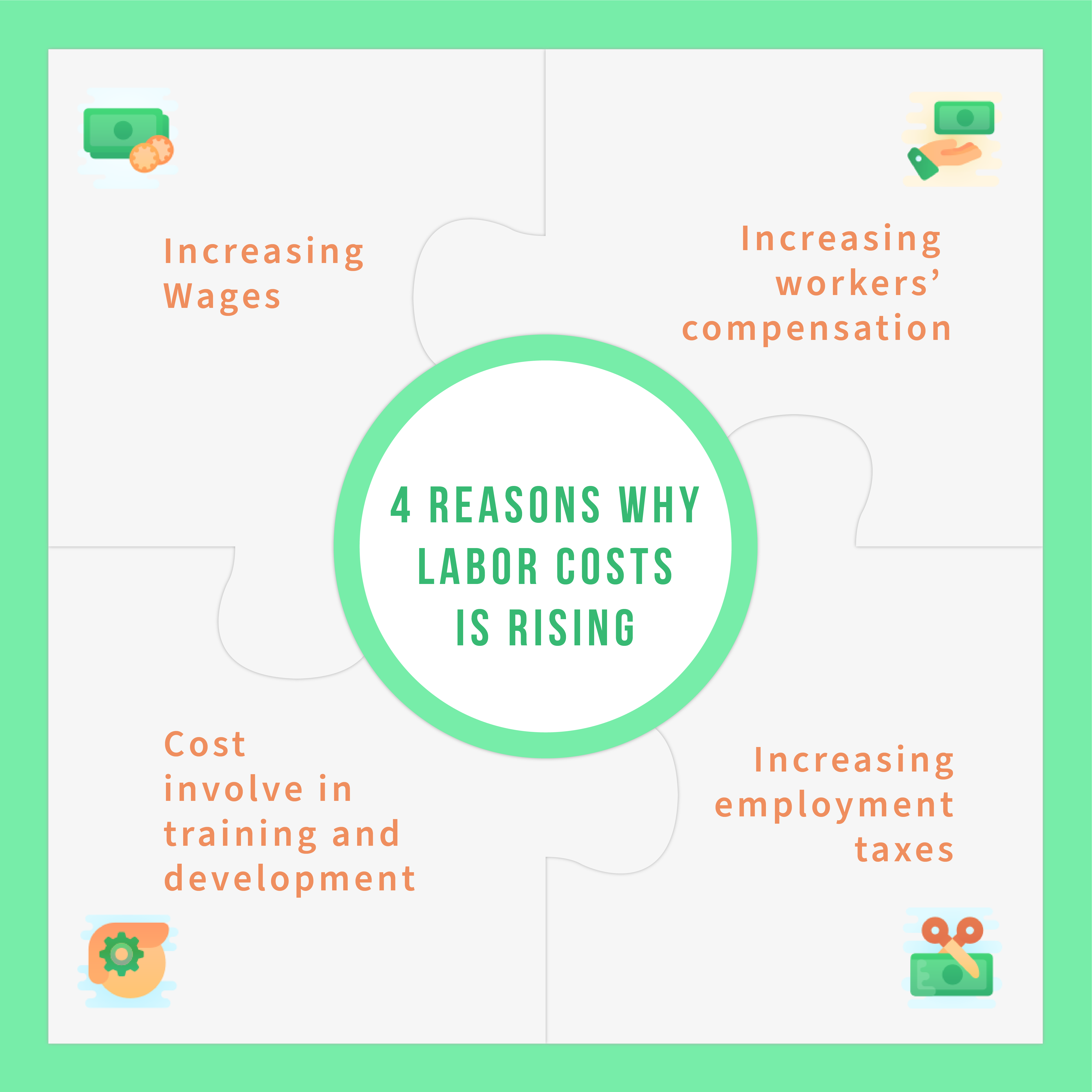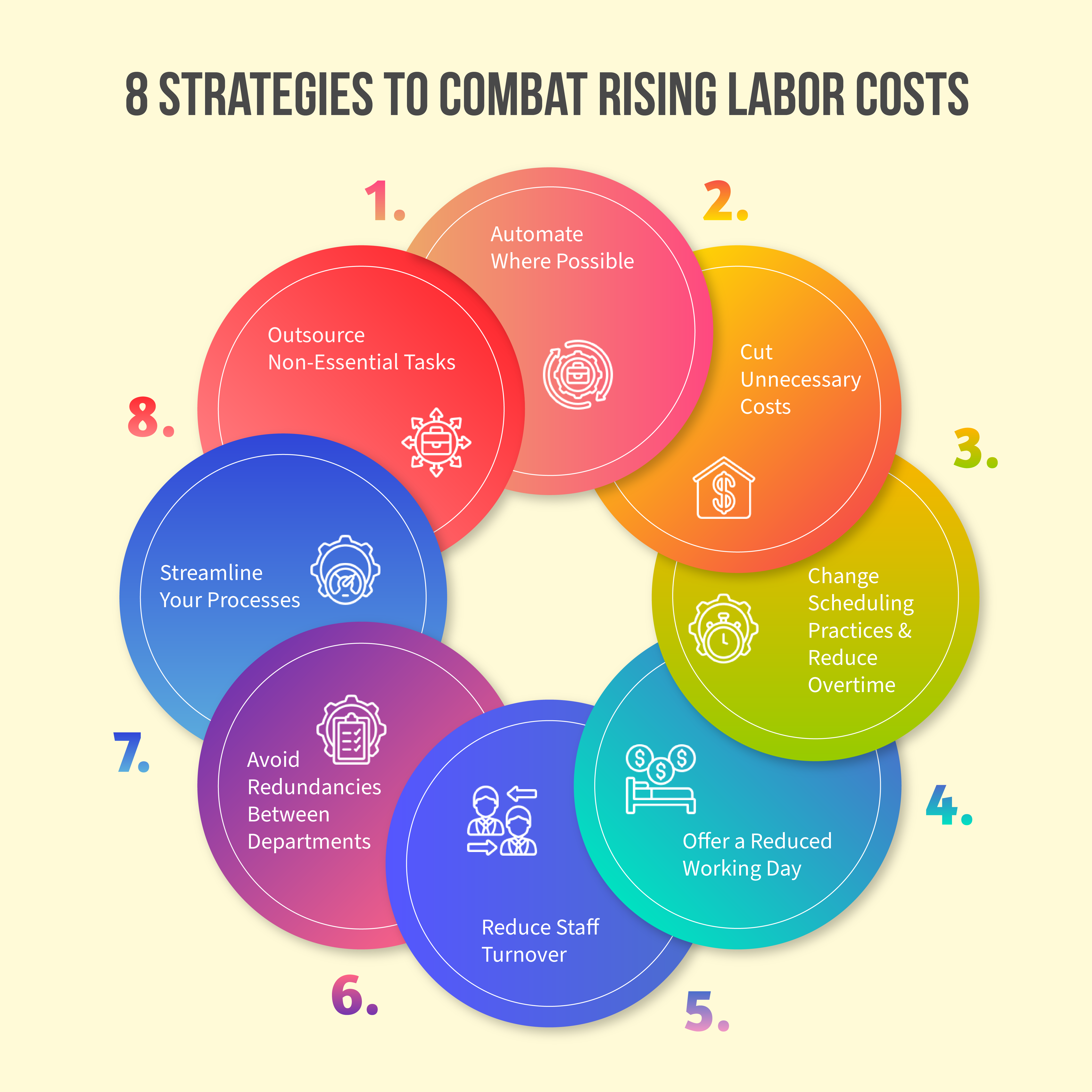Table of Content
Share This Article
- Reading Time: 8 Minutes
- Published: May 24, 2023
- Last Updated: January 17, 2025
In the business world, labor costs are one of the biggest expenses companies have to deal with. As wages rise and competition gets steeper, it is increasingly common for businesses to struggle with managing their bottom line. But fear not! Some cost-effective strategies can help combat rising labor costs with ease if implemented with finesse. Before learning about these strategies, let us first learn about labor cost components, as this will help us understand where and what expenses can be reduced while retaining a productive and engaged workforce.
What Are Labor Costs?
Labor costs are the expenses associated with hiring and compensating employees for their work. Labor costs generally include wages or salaries, benefits such as health insurance, 401(k) contributions, paid time off, and other perks or incentives. Additionally, labor costs can also include taxes and other fees paid by employers on behalf of employees, like social security, Medicare taxes, and unemployment insurance. Labor costs are a necessary expense for most businesses across various industries and can impact a company’s profitability and competitiveness in the market. The two types of labor costs are direct labor costs and indirect labor costs.
- Direct Labor Costs: These are the costs directly associated with producing or delivering goods or services. Direct labor costs include wages, salaries, benefits, and other expenses directly related to the labor required to produce a specific product or deliver a particular service.
- Indirect Labor Costs: These are the costs that are not directly related to the production or delivery of goods and services but support the overall operation of a business. Indirect labor costs can include salaries and wages for administrative staff, human resources personnel, and other support staff who do not directly contribute to the production process. They also include costs associated with employee benefits such as health insurance, 401(k) contributions, and paid time off.
What are the Causes of Rising Labor Costs?
Rising labor costs can be caused by a number of factors, including:

- Increasing wages: Wages are the biggest component of labor costs, and they have been rising steadily in recent years. It is due to a variety of factors, including inflation and the increasing cost of living.
- Increasing workers’ compensation: The cost of workers’ compensation insurance has been rising due to an increase in claims and the growing cost of medical care. As a result, employers have been facing higher labour costs. In some cases, these higher costs have been passed on to consumers in the form of higher prices for goods and services.
- Increasing employment taxes: Taxes on employment, such as Social Security and Medicare, have also been going up in recent years. The more employees an employer has, the more these taxes will cost the employer. Additionally, these taxes can make it more difficult for employers to offer competitive wages to their employees.
- The cost involved in training and development: As businesses strive to remain competitive, they invest more in employee training and development. It includes both formal programs and on-the-job training.
Why It Is Important To Combat Rising Labor Costs
One should consider combatting rising labor costs because they can significantly impact a business’s financial health and sustainability. Labor costs can account for a significant portion of a company’s operating expenses, and without effective cost management strategies, these costs can escalate and negatively affect profitability and competitiveness in the market.
Combating rising labor costs can help businesses allocate their resources more effectively while maintaining healthy margins. Taking proactive measures like streamlining processes, implementing automation solutions, and optimizing staffing levels can help reduce labor costs and improve operational efficiency.
Additionally, managing labor costs can help organizations attract and retain top talent by offering competitive wages and benefits that fit within their budget. This can lead to increased productivity, improved quality of work, and overall success of the business.
To sum up, combatting labor cost is one of the important tasks that you need to conduct as a business owner to help in higher profit. The good news is that you can do so in part by implementing various strategies. Some top strategies include delegating your non-core activities like accounting to expert accounting outsourcing companies, implementing automation, reducing staff turnover, etc. We have prepared a list of eight effective ways by which businesses can combat rising labor costs without sacrificing quality or productivity. So, buckle up and get ready to learn some powerful tips!
8 Strategies to Combat Rising Labor Costs

1. Automate Where Possible: Automation is a great way to reduce labor costs. If there are tasks that can be automated within your business, then do so. For example, businesses can automate invoice processing, payroll, and similar repetitive tasks. There are many different types of automation software available, so be sure to do your research and find one that fits your needs and budget. Automating repetitive tasks can help you reduce the number of personnel required for conducting that task, further cutting down on labor costs.
2. Cut Unnecessary Costs: Tracking and cutting down on unnecessary labor-related costs is another thing businesses can focus on to deal with the rising labor costs and enhance profits. Here are a few instances where businesses can save on unnecessary costs:
- Review your business expenses and look for areas where you can cut back. It could include reducing or eliminating unnecessary marketing expenses, scaling back on office space or equipment, or cutting back on employee perks and benefits.
- Utilize temporary or contract workers when possible. It can help you avoid the added costs of benefits and vacation pay for full-time employees.
3. Change Scheduling Practices & Reduce Overtime: In order to combat rising labor costs, it is important to review and change scheduling practices. It may include reducing overtime, as well as ensuring that employees are scheduled for their most productive hours. By doing so, organizations can make the most of their workforce and reduce labor costs without compromising quality or service.
4. Offer a Reduced Working Day: Offering a reduced working day can be an effective strategy to combat rising labor costs. By reducing the number of hours your employees work, you can save on labor costs while still providing them with the same pay level. It can be an effective strategy, especially if you have employees willing to work fewer hours but can still get their work done efficiently.
If you are considering implementing a reduced working day, you should keep a few things in mind. First, you will need to make sure that your employees can complete their work within the reduced number of hours. If they are not, it could lead to lower productivity and ultimately offset any savings you might achieve from reduced labor costs. Second, you will need to consider how a reduced working day will impact your business operation as a whole. For example, if you have customers who rely on your business being open during the weekend, a reduced working day may not be feasible.
Ultimately, whether or not offering a reduced working day is right for your business will come down to your specific business situation. If you think it could be beneficial, it is worth considering as a way to combat rising labor costs.
5. Reduce Staff Turnover: There are a number of strategies you can use to reduce staff turnover, such as offering competitive salaries and benefits, providing opportunities for professional development, and creating a positive workplace culture. By reducing staff turnover, you can reduce the labor costs that will come with new employees asking for higher pay than your existing employees and eliminate hiring costs.
6. Avoid Redundancies Between Departments: In order to avoid redundancies between departments, it is important to communicate and collaborate between these groups. When individual departments are siloed off from one another, it creates inefficiencies and can lead to potential errors. It also increases the work for personnel and sometimes even causes increased personnel requirements. By sharing information and working together, organizations can reduce wastage and save time and money that might have to be invested in human resources.
7. Streamline Your Processes: Another way to save on labor costs is by streamlining your processes. It could involve anything from simplifying your tasks to implementing strict working principles. By streamlining your processes, you can reduce waste and improve efficiency, both of which will save you money in the long run.
8. Outsource Non-Essential Tasks: Another cost-effective strategy is to outsource non-essential tasks. It can help free up your employees’ time so they can focus on more important tasks and save you money on labor costs. There are many companies that offer outsourcing services, so be sure to look around and find one that fits your needs and budget. The most outsourced business task is accounting. You can outsource the processes you need help with, such as outsourcing your payroll process to a payroll outsourcing services provider or outsourcing your accounts payable function to an accounts payable services provider.
Conclusion
As businesses strive to keep their labor costs in check, these 8 cost-effective strategies can help. Investing a little time and effort into researching new ways to manage your workforce ensures that your company’s labor costs remain manageable. Long-term investments such as better training techniques can also pay off in terms of improved worker productivity, making them an excellent way not just to save money but also to boost efficiency within your business. Choosing outsourcing services, such as payroll outsourcing services, accounts receivable services, or accounting services, helps manage your accounting function and enables cost savings.
If you are a business owner looking for ways to cut down labor costs and save some money for other productive tasks, you can begin by outsourcing your accounting and bookkeeping needs. For this, you will need an expert outsourced services provider, such as Whiz Consulting. We at Whiz Consulting offer expert accounting and bookkeeping services to businesses from different industries with the help of our professionals, who are proficient in using the latest accounting software and tools. We offer cost-effective services to help businesses save costs and resources, helping to strive toward growth and success.

Get customized plan that supports your growth

Thousands of business owners trust Whiz to manage their account
Let us take care of your books and make this financial year a good one.








